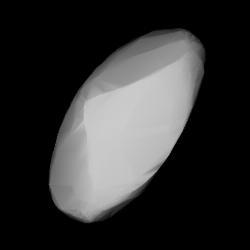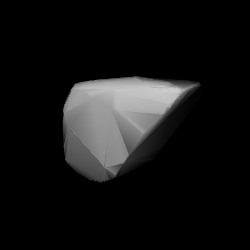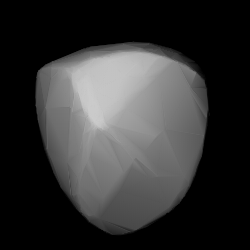Related Research Articles
3043 San Diego, provisional designation 1982 SA, is a stony Hungaria asteroid and slow rotator from the inner regions of the asteroid belt, approximately 4.7 kilometers in diameter.
1019 Strackea, provisional designation 1924 QN, is a stony Hungaria asteroid of the inner asteroid belt, approximately 8 kilometers in diameter. It was discovered on 3 March 1924, by astronomer Karl Reinmuth at Heidelberg Observatory in southwest Germany. It is named for German astronomer Gustav Stracke.
4031 Mueller, provisional designation 1985 CL, is a Hungaria asteroid from the inner regions of the asteroid belt, approximately 4 kilometers in diameter. It was discovered on 12 February 1985, by American astronomer Carolyn Shoemaker at Palomar Observatory, California, and named after astronomer Jean Mueller.
3225 Hoag, provisional designation 1982 QQ, is a dynamical Hungaria asteroid from the innermost regions of the asteroid belt, approximately 5.5 kilometers in diameter. It was discovered on 20 August 1982, by American astronomer couple Carolyn and Eugene Shoemaker at the Palomar Observatory in California. The stony S/L-type asteroid has a short rotation period of 2.37 hours. It was named for American astronomer Arthur Hoag.

2839 Annette is a bright Flora asteroid from the inner regions of the asteroid belt. It was discovered on 5 October 1929, by American astronomer Clyde Tombaugh at Lowell Observatory during his search for Pluto. The presumed S-type asteroid has a rotation period of 10.5 hours and measures approximately 5 kilometers in diameter. It was named after the discoverer's daughter.
1919 Clemence, provisional designation 1971 SA, is a bright Hungaria asteroid and suspected tumbler from the inner regions of the asteroid belt, approximately 4 kilometers in diameter. It was discovered on 16 September 1971, by American astronomer James Gibson together with Argentine astronomer Carlos Cesco at the Yale-Columbia Southern Station at Leoncito Astronomical Complex in Argentina. It is named after astronomer Gerald Clemence.
3915 Fukushima, provisional designation 1988 PA1, is a carbonaceous asteroid from the inner regions of the asteroid belt, approximately 21 kilometers in diameter.

1694 Kaiser is a carbonaceous background asteroid from the inner regions of the asteroid belt, approximately 16 kilometers in diameter. It was discovered on 29 September 1934, by Dutch astronomer Hendrik van Gent at Leiden Southern Station, annex to the Johannesburg Observatory in South Africa. It is named for Dutch astronomer Frederik Kaiser.
4868 Knushevia, provisional designation 1989 UN2, is a bright Hungaria asteroid and suspected binary system from the innermost regions of the asteroid belt, approximately 2 kilometers in diameter. It was discovered on 27 October 1989, by American astronomer Eleanor Helin at the Palomar Observatory in California, United States. The asteroid was named for the Kyiv University in Ukraine.

2204 Lyyli is a dark asteroid and very eccentric Mars-crosser from the middle region of the asteroid belt, approximately 25 kilometers in diameter. It was discovered on 3 March 1943 by Finnish astronomer Yrjö Väisälä at Turku Observatory in Southwest Finland.
1355 Magoeba, provisional designation 1935 HE, is a Hungaria asteroid and a suspected contact-binary from the innermost regions of the asteroid belt, approximately 5 kilometers in diameter. It was discovered on 30 April 1935, by English-born, South African astronomer Cyril Jackson at the Johannesburg Observatory in South Africa. The asteroid is named for Magoeba, a tribal chief in the South African Transvaal Province.
9165 Raup, provisional designation 1987 SJ3, is a stony Hungaria asteroid and exceptionally slow rotator from the inner regions of the asteroid belt, approximately 4.7 kilometers in diameter.

1854 Skvortsov (prov. designation: 1968 UE1) is a stony background asteroid and relatively slow rotator from the middle region of the asteroid belt, approximately 9 kilometers in diameter. It was discovered on 22 October 1968, by Russian astronomer Tamara Smirnova at the Crimean Astrophysical Observatory in Nauchnyj on the Crimean peninsula. It is named after astronomer Evgenii Skvortsov.
For other uses, see Steel (disambiguation).

4765 Wasserburg (prov. designation: 1986 JN1) is a bright Hungaria asteroid, suspected binary system and asteroid pair from the innermost regions of the asteroid belt, approximately 3 kilometers (1.9 miles) in diameter. It was discovered on 5 May 1986, by American astronomer Carolyn Shoemaker at Palomar Observatory, and later named after geologist Gerald J. Wasserburg.
3823 Yorii, provisional designation 1988 EC1, is a carbonaceous asteroid from the outer region of the asteroid belt, approximately 11 kilometers in diameter.
4440 Tchantchès, provisional designation 1984 YV, is a rather elongated Hungaria asteroid and a possible binary system from the inner regions of the asteroid belt, approximately 3 kilometers in diameter.

1600 Vyssotsky, provisional designation 1947 UC, is a rare-type Hungaria asteroid and suspected interloper from the inner regions of the asteroid belt, approximately 7 kilometers in diameter. It was discovered on 22 October 1947, by American astronomer Carl Wirtanen at Lick Observatory in California, United States. It was named after astronomer Alexander Vyssotsky.
(6382) 1988 EL is a stony Hungaria asteroid from the inner regions of the asteroid belt, approximately 5 kilometers in diameter. It was discovered on 14 March 1988, by American astronomer Jeffrey Alu at the U.S. Palomar Observatory, California.
8026 Johnmckay, provisional designation 1991 JA1, is a binary Hungaria asteroid and very slow rotator from the inner regions of the asteroid belt, approximately 2 kilometers in diameter. It was discovered on 8 May 1991, by American astronomer Eleanor Helin at the U.S. Palomar Observatory, California, and later named for NASA test pilot John B. McKay.
References
- 1 2 3 4 "JPL Small-Body Database Browser: 5175 Ables (1988 VS4)" (2017-05-05 last obs.). Jet Propulsion Laboratory . Retrieved 20 June 2017.
- 1 2 3 Schmadel, Lutz D. (2007). "(5175) Ables". Dictionary of Minor Planet Names – (5175) Ables. Springer Berlin Heidelberg. p. 445. doi:10.1007/978-3-540-29925-7_5021. ISBN 978-3-540-00238-3.
- 1 2 3 4 5 6 7 "LCDB Data for (5175) Ables". Asteroid Lightcurve Database (LCDB). Retrieved 27 April 2016.
- 1 2 3 4 Masiero, Joseph R.; Mainzer, A. K.; Grav, T.; Bauer, J. M.; Cutri, R. M.; Nugent, C.; et al. (November 2012). "Preliminary Analysis of WISE/NEOWISE 3-Band Cryogenic and Post-cryogenic Observations of Main Belt Asteroids". The Astrophysical Journal Letters. 759 (1): 5. arXiv: 1209.5794 . Bibcode:2012ApJ...759L...8M. doi:10.1088/2041-8205/759/1/L8 . Retrieved 13 January 2016.
- 1 2 3 4 Mainzer, A.; Grav, T.; Masiero, J.; Hand, E.; Bauer, J.; Tholen, D.; et al. (November 2011). "NEOWISE Studies of Spectrophotometrically Classified Asteroids: Preliminary Results". The Astrophysical Journal. 741 (2): 25. arXiv: 1109.6407 . Bibcode:2011ApJ...741...90M. doi:10.1088/0004-637X/741/2/90 . Retrieved 27 April 2016.
- 1 2 Warner, Brian D. (July 2014). "Asteroid Lightcurve Analysis at CS3-Palmer Divide Station: 2014 January-March". The Minor Planet Bulletin. 41 (3): 144–155. Bibcode:2014MPBu...41..144W. ISSN 1052-8091 . Retrieved 13 January 2016.
- 1 2 Warner, Brian D. (April 2014). "Asteroid Lightcurve Analysis at CS3-Palmer Divide Station: 2013 September-December". The Minor Planet Bulletin. 41 (2): 102–112. Bibcode:2014MPBu...41..102W. ISSN 1052-8091 . Retrieved 13 January 2016.
- ↑ Veres, Peter; Jedicke, Robert; Fitzsimmons, Alan; Denneau, Larry; Granvik, Mikael; Bolin, Bryce; et al. (November 2015). "Absolute magnitudes and slope parameters for 250,000 asteroids observed by Pan-STARRS PS1 - Preliminary results". Icarus. 261: 34–47. arXiv: 1506.00762 . Bibcode:2015Icar..261...34V. doi:10.1016/j.icarus.2015.08.007 . Retrieved 27 April 2016.
- 1 2 "5175 Ables (1988 VS4)". Minor Planet Center. Retrieved 27 April 2016.
- ↑ Warner, Brian D. (January 2011). "Lightcurve Analysis at the Palmer Divide Observatory: 2010 June-September". The Minor Planet Bulletin. 38 (1): 25–31. Bibcode:2011MPBu...38...25W. ISSN 1052-8091 . Retrieved 13 January 2016.
- ↑ "MPC/MPO/MPS Archive". Minor Planet Center. Retrieved 27 April 2016.